Cognitive Psych Exam #2
1/72
There's no tags or description
Looks like no tags are added yet.
Name | Mastery | Learn | Test | Matching | Spaced |
|---|
No study sessions yet.
73 Terms
Attention
The ability to focus on specific stimuli or locations in our environment
Types of Attention – Selective
Attending to one thing while ignoring others
Types of Attention – Divided
Paying attention to more than one thing at a time
Dichotic listening (Who and how the research happened)
– Colin Cherry (1953)
– One message is presented to the left ear and another to the right ear.
– Participant “shadows” one message to ensure he is attending to that message.
– Can we completely filter out the message to the unattended ear and attend only to the shadowed message?
Dichotic listening (What does the research suggest about what we are able to notice?)
Participants could not report the content of the message in unattended ear:
– Knew that there was a message
– Knew the gender of the speaker
Dichotic listening (What does the research suggest about what we are able to notice?)
However, unattended ear is being processed at some level:
– Cocktail party effect
– Change in gender is noticed
– Change to a tone is noticed
Everything with models of selective attention – Early
Where does the attention filter occur?
– Early in processing
– Later in processing
Everything with models of selective attention – Early
Early Selection Model Basics
– Broadbent’s filter model
– Filters message before incoming information is analyzed for meaning
Everything with models of selective attention – Early
Sensory memory
– Holds all incoming information for a fraction of a second
– Transfers all information to next stage
Everything with models of selective attention – Early
Filter
– Identifies attended message based on physical characteristics
– Only attended message is passed on to the next stage
Everything with models of selective attention – Early
Detector
Processes all information to determine higher-level characteristics of the message
Everything with models of selective attention – Early
Short-term memory
– Receives output of detector
– Holds information for 10–15 seconds and may transfer it to long-term memory
Everything with models of selective attention – Early
Broadbent’s Model Could Not Explain
– Why participant’s name gets through
– Why participants can shadow meaningful messages that switch from one ear to another
– Dear Aunt Jane (Gray & Wedderburn, 1960)
– Participants would hear “Dear 7 Jane” in the attended ear and “9 Aunt 6” in the unattended ear
Everything with models of selective attention – Intermediate
Intermediate selection model
– Treisman’s attenuation model
– Attended message can be separated from unattended message early in the information-processing system.
– Selection can also occur later.
– Treisman’s model has been called a “leaky filter” model.
Everything with models of selective attention – Intermediate
Attenuator
– It analyzes incoming message in terms of physical characteristics, language, and meaning.
– Attended message is let through the attenuator at full strength.
– Unattended message is let through at much weaker strength.
Everything with models of selective attention – Intermediate
Dictionary unit
– Contains words, each of which has a threshold for being activated
– Words that are common or important have low thresholds
– For example, your name has a low threshold
– Uncommon words have high thresholds
Everything with models of selective attention – Late
Late selection model
– MacKay (1973)
– Selection of stimuli for final processing does not occur until after information has been analyzed for meaning.
Everything with models of selective attention – Late
MacKay Experiment Basics
– In attended ear, participants heard ambiguous sentences.
– “They were throwing stones at the bank.”
– In unattended ear, participants heard either “river” or “money.”
Everything with models of selective attention – Late
MacKay Experiment Results
– Participants chose which was closest to the meaning of attended message:
– “They threw stones toward the side of the river yesterday.”
– “They threw stones at the savings and loan association yesterday.”
– Meaning of the biasing word affected participants’ choice.
– Participants were unaware of the presentation of the biasing words.
– MacKay and other theorists proposed that most of the incoming information is processed to the level of meaning before the message to be further processed is selected.
Load theory of attention
Processing capacity
– How much information a person can handle at any given moment
Perceptual load
– The difficulty of a given task
Load theory of attention
Perceptual Load Types
High-load (Difficult)
– Tasks use higher amounts of processing capacity
Low-load (Easy)
– Tasks use lower amounts of processing capacity
Stimulus salience
– Areas that stand out and capture attention
– Bottom-up process (Bottom-up Determinants of Eye Movement)
– Depends on characteristics of the stimulus
– Color and motion are highly salient
Scene Schema
– Knowledge about what is contained in typical scenes
– Help guide fixations from one area of a scene to another
Feature Integration Theory
Preattentive Stage
– First Stage
– Automatic
– No effort or attention
– Unaware of process
– Object analyzed into features
Feature Integration Theory
Focused Attention Stage
– Attention plays key role
– Features are combined
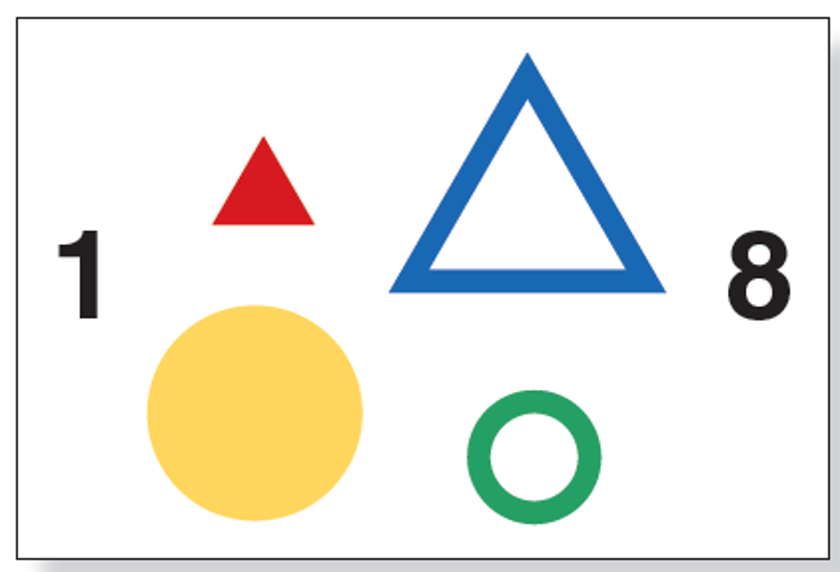
Feature Integration Theory
Researchers
– Treisman and Schmidt (1982)
– Participants report combination of features from different stimuli.
– Illusory conjunctions occur because features are “free floating.”
– Illusory conjunctions: Combining features from different stimuli

Feature Integration Theory
How It Works
– Mostly bottom-up processing
– Top-down processing influences processing when participants are told
what they would see
– Top-down processing combines with feature analysis to help one perceive things accurately
Memory
– Processes involved in retaining, retrieving, and using information about stimuli, images, events, ideas, and skills after the original information is no longer present
– Active any time some past experience has an impact on how you think or behave now or in the future
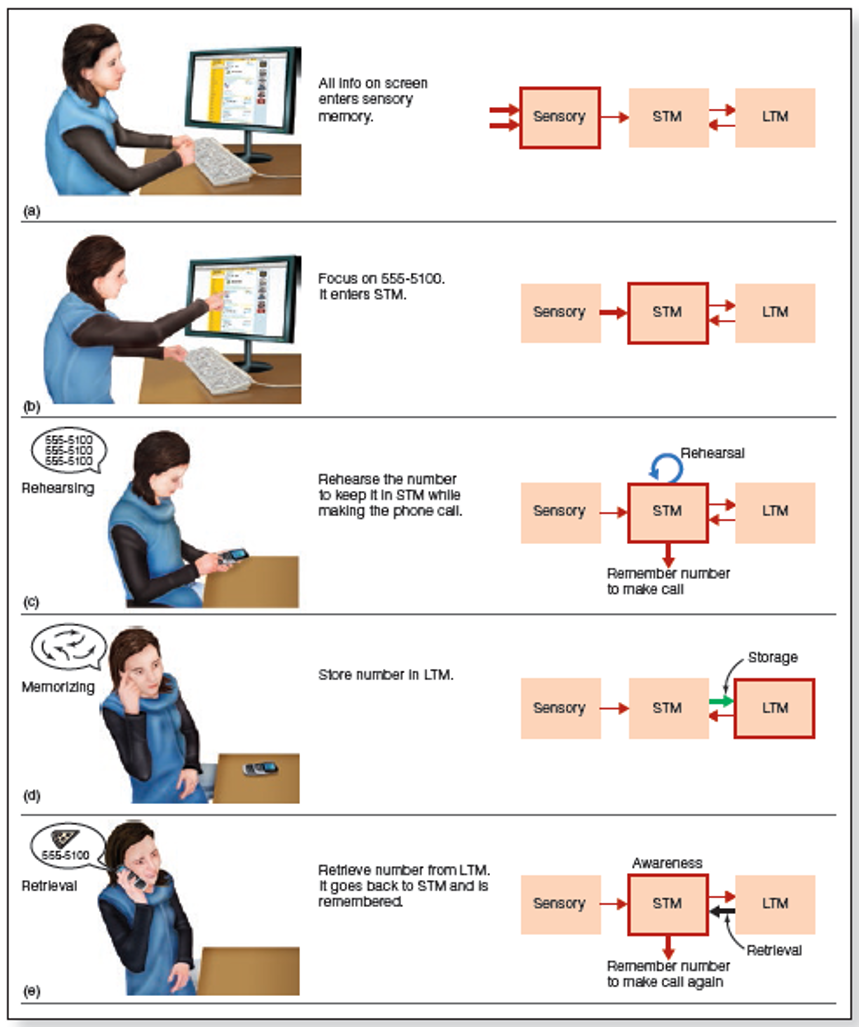
Modal Model of Memory (Atkinson and Shiffrin (1968))
Memory Types
Sensory memory
– initial stage that holds all incoming information for seconds or fractions of a second
Short-term memory
– Holds five to seven items for about 15 to 20 seconds.
Long-term memory
– Can hold a large amount of information for years or even decades
Modal Model of Memory (Atkinson and Shiffrin (1968))
Control processes
– Active processes that can be controlled by the person; strategies associated with the different types of memory
– Rehearsal
– Strategies used to make a stimulus more memorable
– Strategies of attention that help you focus on information that is particularly important or interesting
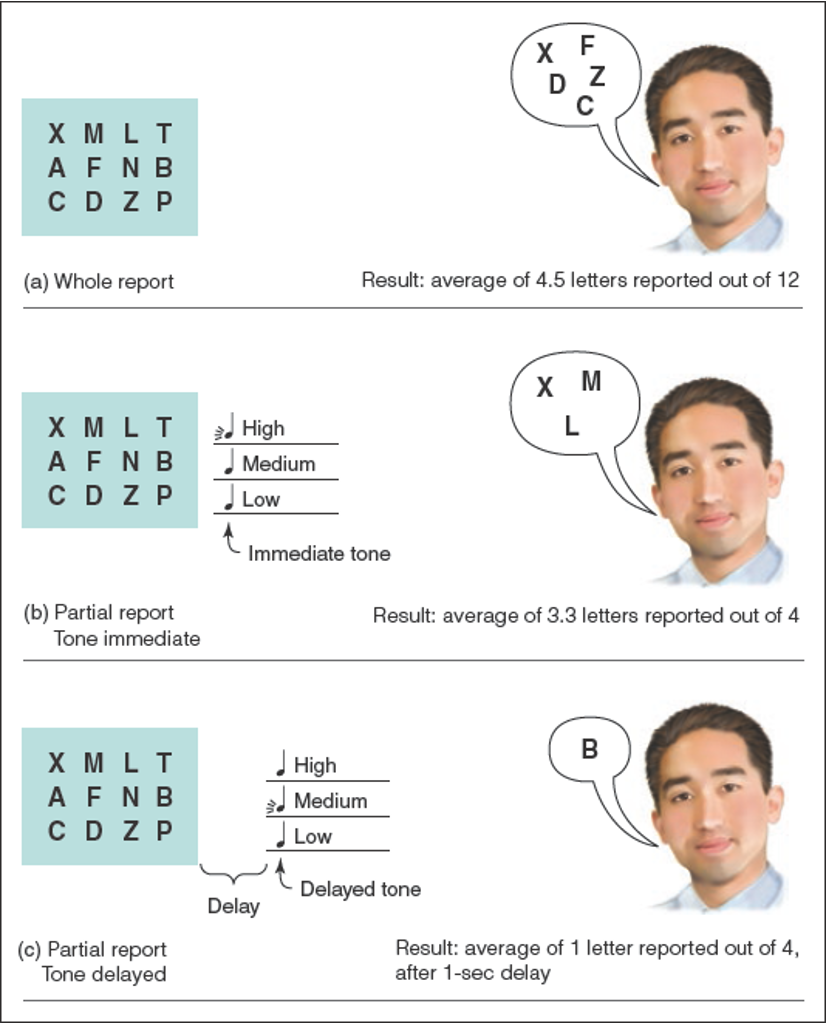
Sensory memory
What are some examples?
– Initial stage that holds all incoming information for seconds or fractions of a second
– Transfers all information to next stage
– Retention, for very brief periods of time, of the effects of sensory stimulation.
– Information decays very quickly
Persistence of vision
– Retention of the perception of light
– Trail of light from a moving sparkler
Iconic Memory
– Brief sensory memory of the things that we see
– Responsible for persistence of vision
Echoic Memory
– Brief sensory memory of the things that we hear
– Responsible for persistence of sound
– Example: saying “What?” to a friend, then knowing exactly what they said before they can respond
Short-term memory (STM)
How long does it store information?
– Holds five to seven items for about 15 to 20 seconds
– Includes both new information received from the sensory stores and information recalled from long-term memory
Short-term memory (STM)
Measuring duration of short-term memory (Peterson & Peterson, 1959)
– Read three letters (e.g., FZL), then a three-digit number (e.g., 403)
– Begin counting backwards by threes from that number
– After a set time, recall three letters
– After 3 seconds of counting, participants performed at 80%
– After 18 seconds of counting, participants performed at 10%
– Reduction in performance explained by decay, the vanishing of a memory trace due to the passage of time and exposure to competing stimuli
Short-term memory (STM)
Capacity of short-term memory
– Digit span: how many digits a person can remember
– Typical result: five to eight items
Chunking
– Small units can be combined into larger meaningful units
– Chunk is a collection of elements strongly associated with one another but weakly associated with elements in other chunks
Short-term memory (STM)
Ericsson and coworkers (1980)
– Trained a college student, S.F., with average memory ability to use chunking
– Student had initial digit span of 7
– After 230 one-hour training sessions, S.F. could remember up to 79 digits
– Chunking them into meaningful units
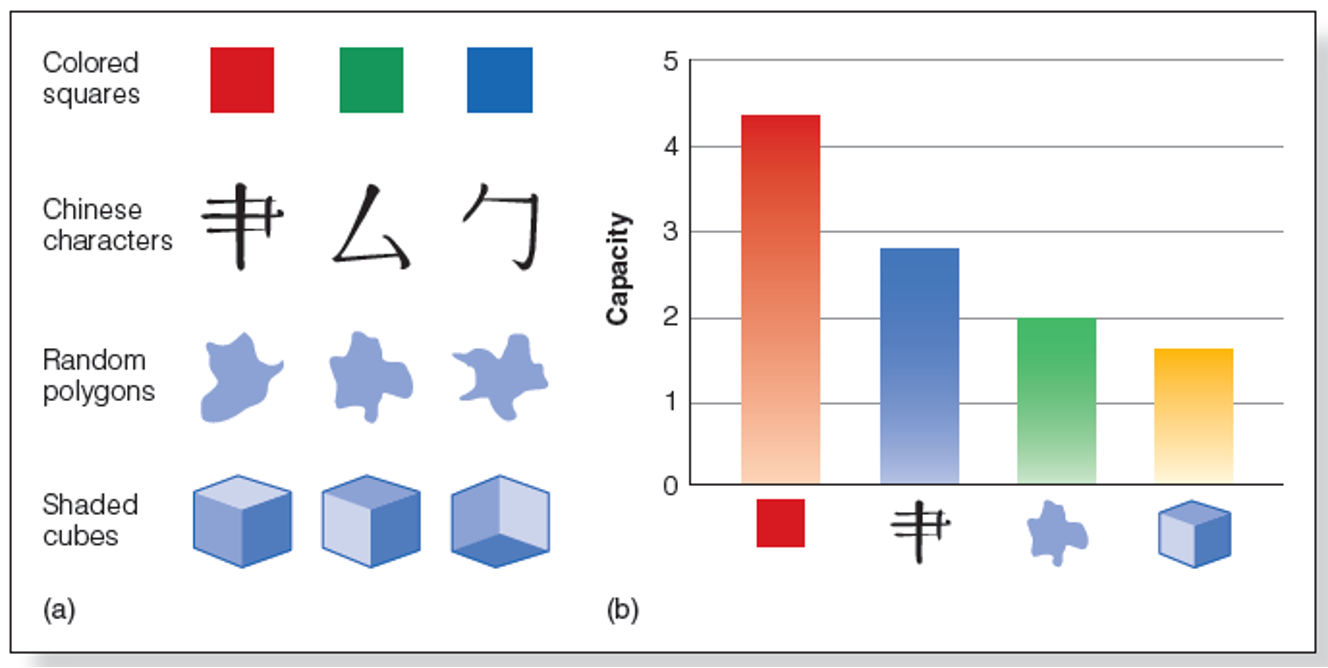
Short-term memory (STM)
Alvarez and Cavanagh (2004)
– Used colored squares as well as complex objects
– Used the change detection procedure
Working memory (WM)
vs
Short-term memory (STM)
Same
– Working memory is a similar concept to short-term memory
Different
– STM holds information for a brief period of time
– WM is concerned with the storage, processing and manipulation of information, and is active during complex cognition
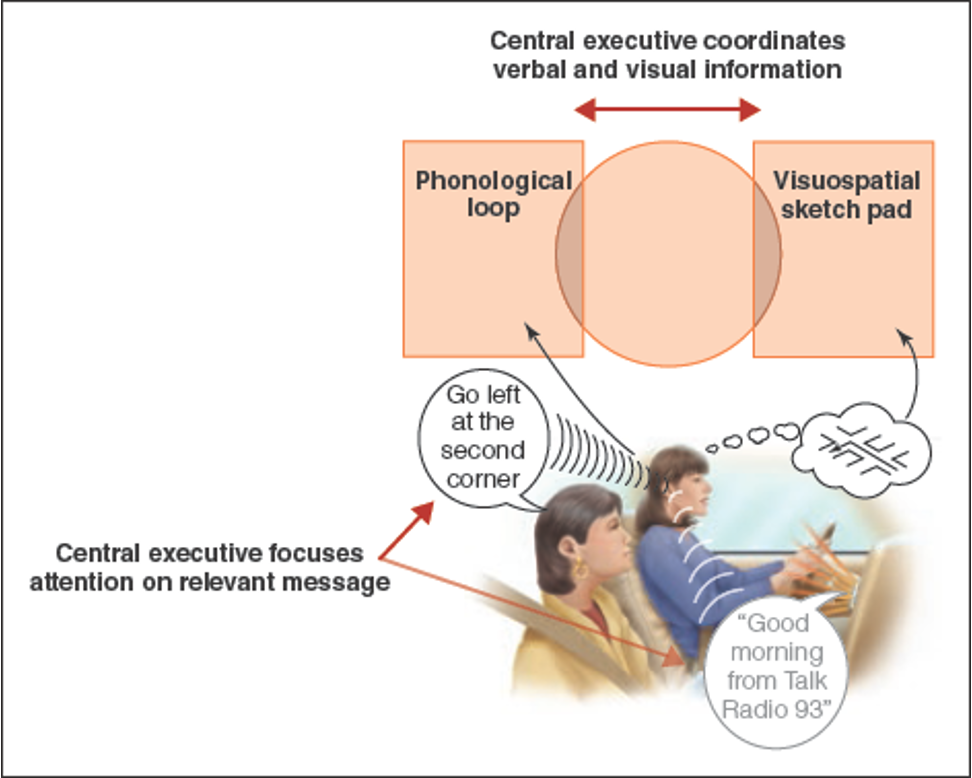
Working memory (WM)
(Baddeley and Hitch (1974))
– Limited-capacity system for temporary storage and manipulation of information for complex tasks such as comprehension, learning, and reasoning
– Working memory is set up to process different types of information simultaneously
– Has trouble when similar types of information are presented at the same time
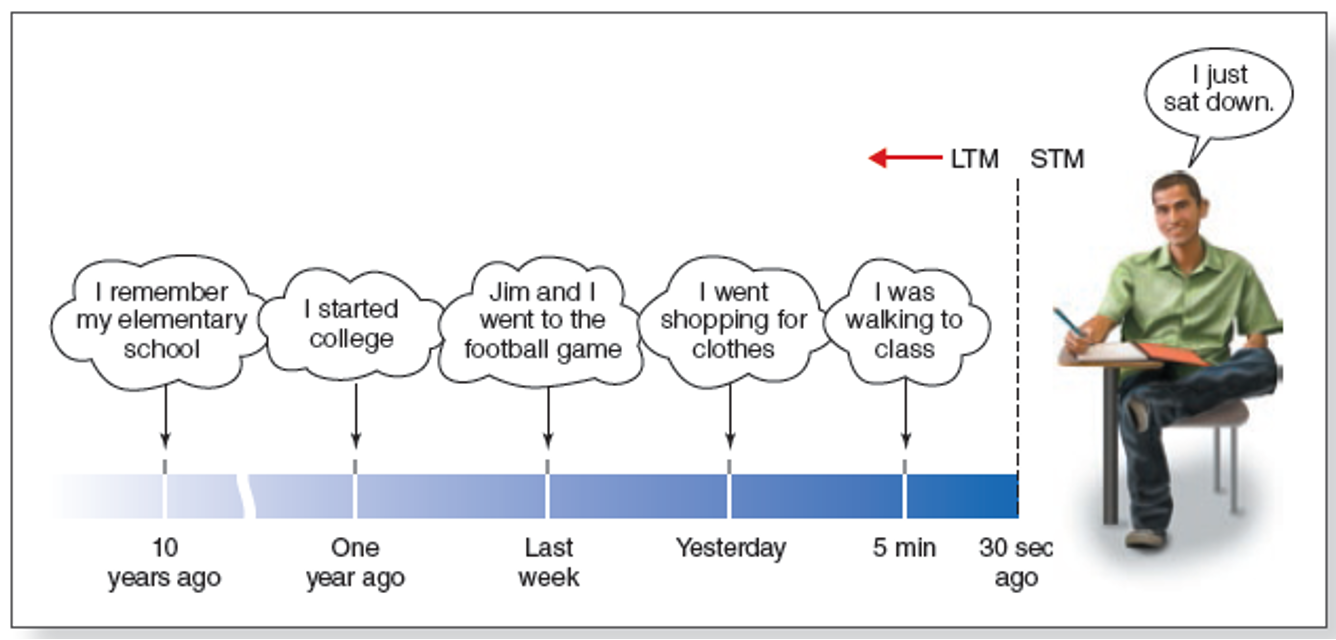
Long-term memory
– Can hold a large amount of information for years or even decades
– “Archive” of information about past events and knowledge learned
– Works closely with working memory
– Storage stretches from a few moments ago to as far back as one can remember
– More recent memories are more detailed
Baddeley’s working memory models
(old and revised)
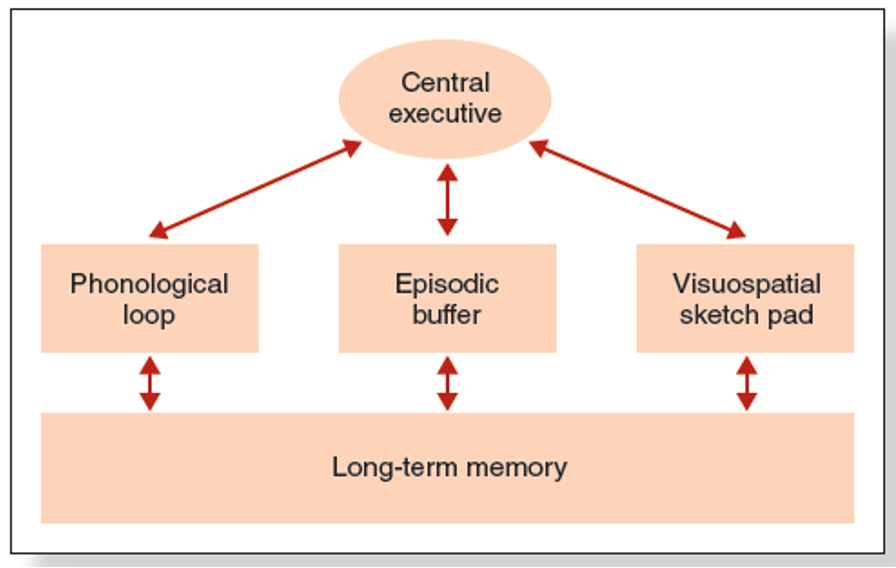
Phonological loop
Three phenomena that support the idea of a phonological loop
– Phonological similarity effect
– Word length effect
– Articulatory suppression
Phonological loop
Phonological similarity effect
– Letters or words that sound (not look) similar are confused
– For example, F may be confused for S or X, rather than for E, when recalling a list of letters seen on a screen
Phonological loop
Word length effect
– Memory for lists of words is better for short words than for long words
– Takes longer to pronounce and rehearse longer words and to produce them during recall
Phonological loop
Articulatory Suppression
– Speaking prevents one from rehearsing items to be remembered
– Reduces memory span
– Eliminates word length effect
Visuospatial sketch pad
– Creation of visual images in the mind in the absence of a physical visual stimulus
– Shepard and Metzler (1971)
– Mental rotation task
– Tasks that called for greater rotations took longer
Central executive
Acts as the attention controller
– Focus, divide, switch attention
– Controls suppression of irrelevant information
– Perseveration: repeatedly performing the same action or thought even if it is not achieving the desired goal
– A common behavior of patients with frontal lobe damage
Examples of situations where
working memory will have trouble
– Working memory is set up to process different types of information simultaneously
– Has trouble when similar types of information are presented at the same time
Phonological similarity effect
– Letters or words that sound (not look) similar are confused
– For example, F may be confused for S or X, rather than for E, when recalling a list of letters seen on a screen
Word length effect
–Memory for lists of words is better for short words than for long words
–Takes longer to pronounce and rehearse longer words and to produce them during recall
Articulatory suppression
– Speaking prevents one from rehearsing items to be remembered
– Reduces memory span
– Eliminates word length effect
Frontal and prefrontal cortex
(association with memory)
Perseveration: repeatedly performing the same action or thought even if it is not achieving the desired goal
– A common behavior of patients with frontal lobe damage
Prefrontal cortex responsible for processing incoming visual and auditory information
– Monkeys without a prefrontal cortex have difficulty holding information in working memory
The prefrontal cortex is important for holding information for brief periods of time
The frontal and prefrontal cortex do not become adequately developed until about 8 months of age
– May explain why infants do not understand object permanence
Primacy effect vs Recency effect
– Primacy effect gave more time to rehearse information, more likely to enter long-term memory (LTM)
– Recency effect: Stimuli still in STM
– Notice that memory is better for words presented at the beginning of the list (primacy effect) and at the end (recency effect).
Different types of coding (visual,
auditory, and semantic)
Code | Short-Term Memory | Long-Term Memory |
Visual | Holding an image in the mind to reproduce a visual pattern that was just seen (Della Sala et al., 1999.) | Visualizing what the Lincoln Memorial in Washington, D.C., looked like when you saw it last summer |
Auditory | Representing the sounds of letters in the mind just after hearing them (Conrad, 1964) | Repeating a song you have heard many times before, over and over in your mind |
Semantic | Placing words in an STM task into categories based on their meaning (Wickens et al., 1976) | Recalling the general plot of a novel you read last week (Sachs) |
Comparing coding in STM and LTM
Auditory coding is the predominant type of coding in STM.
– Coding based on the sound – like repeating a telephone number.
Semantic coding is the most likely form of coding for LTM.
– Coding based on the meaning – like remembering the plot of a story.
Parts of the brain primarily
responsible for STM and LTM
HM
– Surgery removed hippocampus
– Retained short-term memory (STM) but unable to transfer info to long-term memory (LTM)
– Unable to form new LTMs
KF
– Accident damaged parietal lobe
– Impaired STM (reduced digit span) but functional LTM
– Able to form and hold new memories
Double dissociation
– STM and LTM seem to be caused by different mechanisms, which can act independently.
Episodic memory
– Memory for experiences
– Involves mental time travel
– Tied to personal experience; remembering is reliving
– “Self-knowing”
Semantic memory
– Memory for facts
– Does not involve mental time travel
– General knowledge, facts
– “Knowing”
How time affects memories
Forgetting is not an “all-or-nothing” process
– Familiarity: semantic memory
– Recollection: episodic memory
How time affects memories
Remember/Know procedure
– Semanticization of remote memories
– Loss of episodic details for memories of long-ago events
How time affects memories
Forgetting ? with longer intervals after encoding
increases
Constructive episodic simulation
hypothesis
– Episodic memories are extracted and recombined to create simulations of future events
– Helps us to anticipate future needs and guide future behaviors
– Adaptive function similar to mind wandering
– Some researchers have suggested that one of the reasons that the mind wanders is to help people plan for the future by helping create simulations of the future from our episodic memories
Implicit memory
– Occurs when learning from experience is not accompanied by conscious remembering
Three of the main types of implicit memory:
1.Procedural memories
2.Priming
3.Conditioning
Procedural memories
– Skill memory: memory for actions
– May have no memory of where or when learned
– Perform procedures without being consciously aware of how to do them
– People who cannot form new LTMs can still learn new skills (e.g., HM)
Priming
– Presentation of priming stimulus changes person’s response to a test stimulus
Repetition priming
– Test stimulus the same or similar to priming stimulus
– Called implicit memory; person may or may not remember original presentation of priming stimuli
Propaganda effect
– More likely to rate statements read or heard before as being true
– Involves implicit memory because it can occur when people are not aware of previously seeing or hearing statement
– Implications for advertisements
Open-ended Questions (1-2 sentence answers)
List four words that would have a
low threshold for being activated for
the typical MC student, according to the dictionary unit in Treisman’s
Attenuation Model.
Ritalin
Contusion
Epidermis
Hestia
Open-ended Questions (1-2 sentence
answers)
Who was Phineas Gage and what did
his case study teach us about the
brain? Include how his behavior
changed.
Accident caused damage to Gage’s frontal lobe.
Accident changed Gage’s personality from an upstanding citizen to a person with low impulse control, poor ability to plan, and poor social skills.
Open-ended Questions (1-2 sentence
answers)
Describe one of the following case
studies, including the specific part of the brain that was affected and the resulting changes in behavior: HM, KF, KC, or LP.
KF
– Accident damaged parietal lobe
– Impaired STM (reduced digit span) but functional LTM
– Able to form and hold new memories